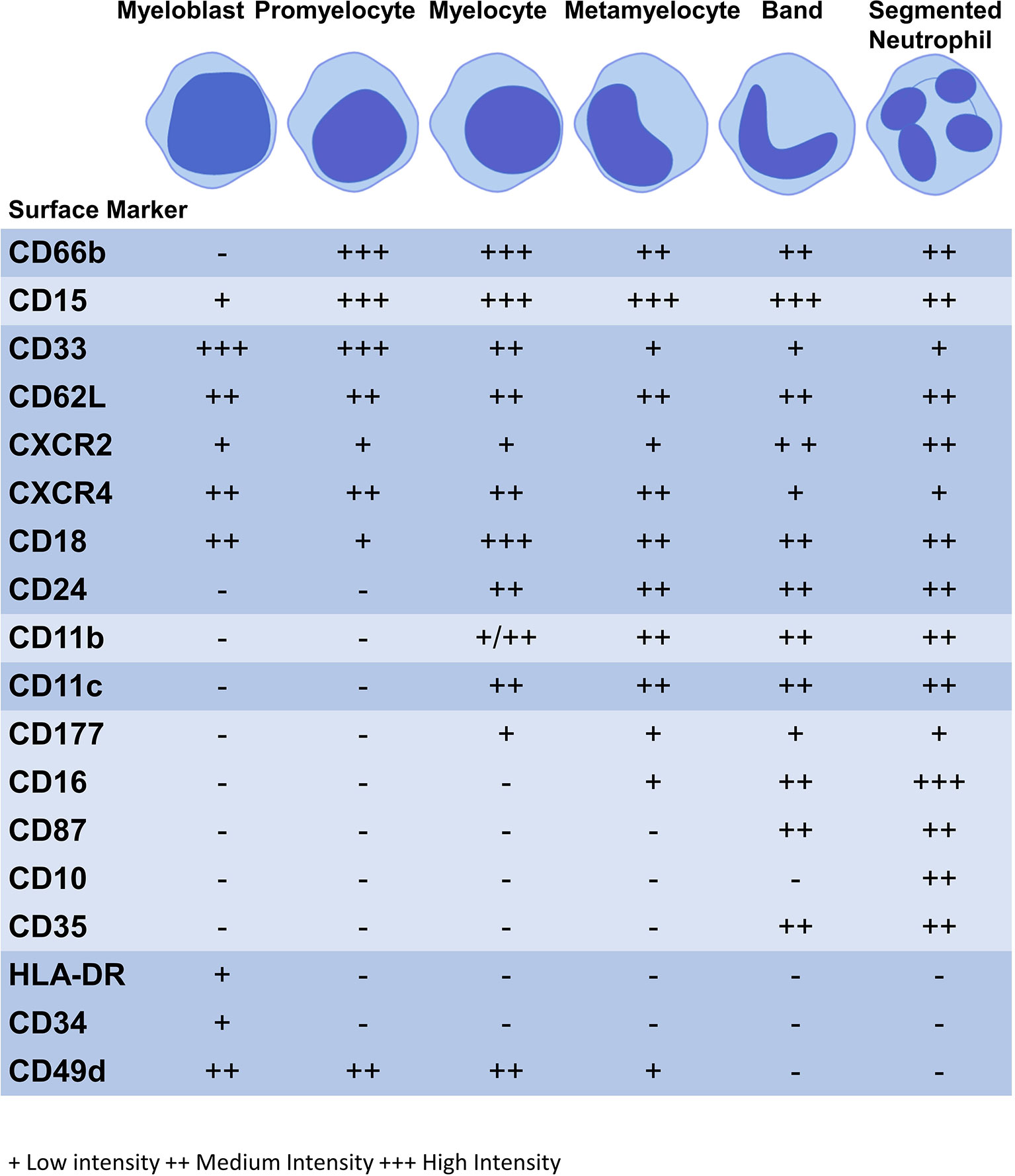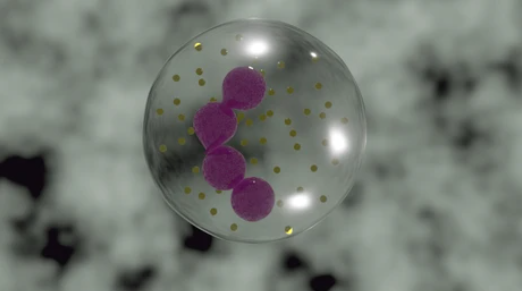CD Antigen (Granulocyte Markers)
Related Symbol Search List
- CD24
- CD32A
- Fcgr2b
- CD45
- L-selectin
- CD93
- CD147
- CD16a
- FCGR3B
- LTBR
- Anpep
- CD164
- CD44
- CD53
- CD69
- CEACAM1
- CEACAM4
- CEACAM5
- CEACAM6
- CLEC4A
- CMA1
- CSF3R
- CD64
- FCGR2C
- GPR84
- HCK
- Il5
- ITGA4
- ITGAM
- ITGAX
- LAMP1
- LAMP2
- LAMP5
- LRG1
- LTB4R
- LTB4R2
- MPO
- MS4A2
- PTPRJ
- S100A4
- S100A8
- S100A9
- Selplg
- SPN
Immunology Background
Available Resources for CD Antigen (Granulocyte Markers) Research
Creative BioMart is dedicated to providing CD antigens (granulocyte markers) related products, services, and resources to researchers, clinicians, and pharmaceutical companies worldwide. All of these are designed to facilitate research into granulocyte markers and their role in various diseases and immune responses.
These include CD antigens (granulocyte markers)-related recombinant proteins, protein precoupled magnetic beads, cell and tissue lysates, antibodies, chromatography reagents, and others. |
We can produce specific antibodies, recombinant proteins, peptides, and others according to customer needs. |
We provide extensive resources on CD antigens (granulocyte markers) to help researchers explore the latest findings. |
About CD Antigen (Granulocyte Markers)
CD antigens, also known as clusters of differentiation antigens, are cell surface molecules that serve as markers for characterizing and identifying different cell types in the immune system. Among the CD antigens, there are specific markers known as granulocyte markers that are expressed on various types of granulocytes, including neutrophils, eosinophils, and basophils (or myeloblast, promyelocyte, myelocyte, metamyelocyte, band cell, segmented neutrophil). These markers play a crucial role in distinguishing and studying granulocyte populations.
Granulocytes are a type of white blood cells characterized by the presence of granules in their cytoplasm. They play a vital role in the immune response, particularly in combating infections. CD antigens associated with granulocytes are particularly useful in immunophenotyping studies, clinical diagnostics, and research focused on understanding granulocyte biology and their involvement in immune responses.
Here are some commonly used CD antigens as granulocyte markers:
- CD15 (also known as Lewis X) is expressed on the surface of neutrophils, eosinophils, and some monocytes. It is widely used as a marker for identifying and enumerating granulocytes in flow cytometry and immunohistochemistry.
- CD16 (FcγRIII) is expressed on neutrophils and monocytes. It plays a role in antibody-dependent cellular cytotoxicity (ADCC) and can be used to distinguish neutrophils from other cell types.
- CD11b (Mac-1) is expressed on neutrophils, eosinophils, and monocytes. It is involved in cell adhesion, migration, and phagocytosis. CD11b is a widely used marker for identifying and studying granulocytes and monocytes.
- CD13 (aminopeptidase N) is expressed on neutrophils, eosinophils, and monocytes. It is an enzyme involved in peptide metabolism and has been implicated in various physiological and pathological processes. CD13 is used as a marker for identifying granulocytes in flow cytometry and immunohistochemistry.
- CD66b (CEACAM8) is highly expressed on neutrophils and is involved in cell adhesion and activation. It is a widely used marker for identifying and gating neutrophils in flow cytometry experiments.
These CD antigens, along with others, are used in combination in flow cytometry panels or immunostaining protocols to accurately identify, enumerate, and analyze granulocyte populations in various biological samples. By utilizing these markers, researchers can gain insights into granulocyte biology, immune responses, and their role in various diseases, contributing to advancements in the field of immunology and clinical diagnostics.
 Fig.1 Expression of surface markers during granulopoiesis. Figure illustrates the surface marker expression at each stage of granulopoiesis; myeloblast, promyelocyte, myelocyte, metamyelocyte, band cell and segmented neutrophil. The intensity of the surface marker is shown whereby; low intensity (+), medium intensity (++) and high intensity (+++). (McKenna E, et al., 2021)
Fig.1 Expression of surface markers during granulopoiesis. Figure illustrates the surface marker expression at each stage of granulopoiesis; myeloblast, promyelocyte, myelocyte, metamyelocyte, band cell and segmented neutrophil. The intensity of the surface marker is shown whereby; low intensity (+), medium intensity (++) and high intensity (+++). (McKenna E, et al., 2021)
Methods of Use of CD Antigens (Granulocyte Markers)
CD antigens (granulocyte markers) can be utilized in various methods to study and analyze granulocyte populations. Here are some common methods of using granulocyte markers CD antigens:
Immunophenotyping by Flow Cytometry
- Flow cytometry is a widely used technique for immunophenotyping, which involves the identification and characterization of different cell populations based on their surface marker expression.
- Fluorescently labeled antibodies specific to CD antigens (granulocyte markers) are used to stain the cells. The stained cells are then analyzed using a flow cytometer, which measures the emitted fluorescence and provides quantitative information about the expression levels of CD antigens on granulocytes.
- Flow cytometry allows for the identification, enumeration, and characterization of granulocyte subsets based on their CD antigen profiles, providing valuable insights into their phenotype and function.
Immunohistochemistry and Immunofluorescence
- Immunohistochemistry and immunofluorescence techniques are used to visualize the presence and localization of specific CD antigens on granulocytes within tissue samples.
- Tissue sections are treated with antibodies specific to the CD antigens of interest, followed by detection with enzyme-conjugated or fluorescently labeled secondary antibodies. The stained tissue sections are examined under a microscope to visualize the distribution and expression patterns of CD antigens on granulocytes.
- Immunohistochemistry and immunofluorescence techniques allow for the examination of CD antigen expression within the context of tissue architecture, facilitating the study of granulocytes in various diseases and tissue microenvironments.
Functional Assays
- CD antigens on granulocytes can also be utilized in functional assays to assess their activity and response to stimuli.
- Functional assays, such as respiratory burst assays or phagocytosis assays, can be conducted using granulocytes isolated from blood or other sources.
- Antibodies specific to CD antigens (granulocyte markers) can be used to identify and isolate the desired granulocyte populations for functional analysis.
- These assays provide insights into the functional capabilities of granulocytes and their ability to respond to infectious agents, inflammatory signals, or other stimuli.
Cell Sorting
- Cell sorting techniques, such as fluorescence-activated cell sorting (FACS), can be employed to isolate specific granulocyte subsets based on their CD antigen expression.
- Fluorescently labeled antibodies targeting CD antigens (granulocyte markers) are used to label the cells, and then the desired granulocyte populations are sorted based on their fluorescence signals.
- Cell sorting allows for the isolation of pure granulocyte populations for downstream applications, such as gene expression analysis, functional assays, or further characterization.
These methods provide valuable tools for studying granulocyte populations and their role in various diseases. By utilizing CD antigens (granulocyte markers), researchers can gain insights into granulocyte biology, immune responses, and the pathogenesis of diseases associated with granulocyte dysfunction, infections, inflammation, and immune disorders.

Potential Applications of CD Antigens (Granulocyte Markers) in Disease Diagnosis and Treatment
The use of CD antigens as granulocyte markers has significant implications in the diagnosis and treatment of diseases related to infections, inflammation, and immune disorders. These markers enable researchers and clinicians to better understand granulocyte populations and their role in various pathological conditions. Here are some potential applications of CD antigens as granulocyte markers in disease diagnosis and treatment:
Infections
Granulocytes, particularly neutrophils, play a crucial role in the immune response against bacterial, fungal, and parasitic infections. CD antigens can be utilized to identify and quantify specific granulocyte subsets involved in the immune response to infection. By analyzing the expression patterns of CD antigens on granulocytes, researchers can assess the activation status and functional properties of these cells, aiding in the diagnosis and monitoring of infectious diseases.
- In the diagnosis of sepsis, CD15 can be used as a granulocyte marker to assess the neutrophil response. Elevated levels of CD15 expression on neutrophils may indicate an ongoing bacterial infection.
- In the evaluation of parasitic infections, CD11b and CD66b can be utilized as granulocyte markers to identify and quantify eosinophils, which play a role in the immune response against parasites.
Inflammatory Disorders
Granulocytes are key contributors to the inflammatory response in various disorders, including asthma, allergic reactions, and autoimmune diseases. CD antigens can help characterize granulocyte subpopulations involved in specific inflammatory conditions. By studying the expression levels and functional markers of CD antigens, researchers can gain insights into the pathogenesis of these disorders and develop targeted therapeutic approaches.
- In asthma, CD16 can be used as a granulocyte marker to distinguish neutrophils from eosinophils. Elevated levels of eosinophils, identified by their CD16 expression, can indicate the presence of eosinophilic airway inflammation.
- In rheumatoid arthritis, CD11b and CD13 can serve as granulocyte markers to assess the activation state and migration of neutrophils at the site of inflammation.
Immune Disorders
Granulocyte dysregulation is often observed in immune disorders such as primary immunodeficiencies and hypersensitivity reactions. CD antigens can serve as diagnostic markers to identify aberrant granulocyte populations and assess their functional defects. This information can guide treatment strategies and help monitor the response to therapies aimed at modulating granulocyte function.
- In primary immunodeficiencies, CD15 and CD66b can be used as granulocyte markers to evaluate the presence and functionality of neutrophils. Decreased expression of these markers may indicate impaired neutrophil function.
- In drug-induced hypersensitivity reactions, CD11b and CD13 can be utilized as granulocyte markers to assess the involvement of neutrophils in the immune response and identify potential drug triggers.
Therapeutic Targeting
CD antigens expressed on granulocytes can also be potential targets for therapeutic interventions. Antibodies or other targeted therapies directed against specific CD antigens can be used to modulate granulocyte activity, migration, or survival. This approach holds promise for the development of novel treatments for granulocyte-related diseases.
- In antibody-based therapies, CD16 can be targeted to enhance antibody-dependent cellular cytotoxicity (ADCC) mediated by neutrophils, leading to improved clearance of pathogens or cancer cells.
- In autoimmune disorders such as systemic lupus erythematosus, CD11b and CD66b can be targeted to modulate the activation and migration of neutrophils, potentially reducing tissue damage and disease progression.
Prognostic Indicators
The expression profiles of CD antigens on granulocytes can provide prognostic information in certain diseases. For example, elevated levels of specific CD antigens on granulocytes may indicate a more severe or aggressive disease state. Monitoring the expression patterns of these markers over time can help assess disease progression and guide treatment decisions.
- In sepsis, monitoring the expression levels of CD15 and CD66b on neutrophils can provide prognostic information. High expression levels may indicate a more severe disease course and increased mortality risk.
- In inflammatory bowel disease, the expression levels of CD11b and CD13 on neutrophils can serve as markers to predict disease severity and guide treatment decisions.
By harnessing the power of CD antigens as granulocyte markers, researchers and clinicians can gain a deeper understanding of granulocyte biology, identify disease-specific alterations in granulocyte populations, and develop targeted diagnostic and therapeutic strategies for a wide range of infectious, inflammatory, and immune disorders.
Contact us today to learn more about our CD antigens (granulocyte markers) products and how we can assist you in your research endeavors. Together, we can make a difference in the field of immunology and beyond.
Related References
- McKenna E, Mhaonaigh AU, Wubben R, et al. Neutrophils: Need for Standardized Nomenclature. Front Immunol. 2021;12:602963.
- de Ruiter K, van Staveren S, Hilvering B, et al. A field-applicable method for flow cytometric analysis of granulocyte activation: Cryopreservation of fixed granulocytes. Cytometry A. 2018;93(5):540-547.
- Vivanco Gonzalez N, Oliveria JP, Tebaykin D, et al. An optimized protocol for phenotyping human granulocytes by mass cytometry. STAR Protoc. 2022;3(2):101280.

